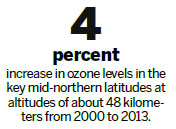Ozone layer recovering, UN science panel says
Earth's protective ozone layer is beginning to recover, largely because of the phase-out since the 1980s of certain chemicals used in refrigerants and aerosol cans, a UN scientific panel reported Wednesday in a rare piece of good news about the health of the planet.
Scientists said the development shows that when the world comes together, it can counteract a brewing environmental crisis.
For the first time in 35 years, scientists were able to confirm a statistically significant and sustained increase in stratospheric ozone, which shields the planet from solar radiation that can cause skin cancer, crop damage and other problems.
From 2000 to 2013, ozone levels climbed 4 percent in the key mid-northern latitudes at altitudes of about 48 kilometers, said NASA scientist Paul A. Newman. He co-chaired the ozone assessment, conducted every four years, by 300 scientists. It was released at the UN.
"It's a victory for diplomacy and for science, and for the fact that we were able to work together," said chemist Mario Molina. In 1974, Molina and F. Sherwood Rowland wrote a scientific study forecasting the ozone depletion problem. They won the 1995 Nobel Prize in chemistry for their work.

The ozone layer had been thinning since the late 1970s. Man-made chlorofluorocarbons, or CFCs, released chlorine and bromine, which destroyed ozone molecules high in the air. After scientists raised the alarm, countries around the world agreed to a treaty in 1987 that phased out CFCs. Levels of those chemicals at altitudes up to 80 km are decreasing.
The UN calculated in an earlier report that without the pact, by 2030 there would have been an extra 2 million skin cancer cases annually around the world.
Paradoxically, heat-trapping greenhouse gases - considered the major cause of global warming - are also helping to rebuild the ozone layer, Newman said. The report said rising levels of carbon dioxide and other gases cool the upper stratosphere, and the cooler air increases the amount of ozone.
In another worrisome trend, the chemicals that replaced CFCs contribute to global warming and are on the rise, according to MIT atmospheric scientist Susan Solomon. At the moment, they don't make much of a dent, but they are expected to increase dramatically by 2050 and make "a big contribution" to global warming.
The ozone layer is still far from healed. The long-lasting, ozone-eating chemicals still lingering in the atmosphere create a yearly autumn ozone hole above the far southern hemisphere, and the hole hasn't closed up.
(China Daily 09/12/2014 page11)














